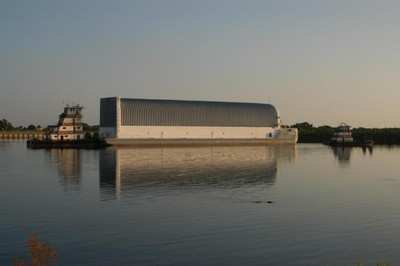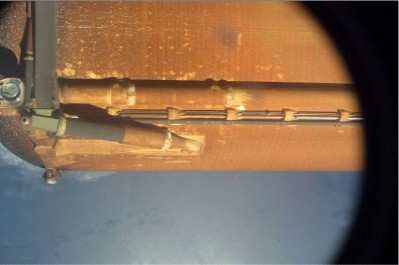Thu, Sep 29, 2005
Michoud Has Recovered Enough To Start Research On STS-114 Foam
Loss
Less than a month after being hit by Hurricane Katrina, NASA's
Michoud Assembly Facility in New Orleans is gearing up to restart
processing space shuttle fuel tanks. The work will address foam
loss during Space Shuttle Discovery's launch in July.

External tank #119, which is expected to be used in the next
shuttle mission, departed NASA's Kennedy Space Center in Florida
today. The huge, orange external tank is being transported by
NASA's solid rocket booster retrieval ship Freedom Star. It will
travel down Florida's Banana River en route to the Gulf of
Mexico-Mississippi River outlet on its 900-mile journey. It's
expected to arrive at Michoud in four or five days.
"The facility is ready to receive the tank and the Michoud team
is eager to get their hands on it," said External Tank Project
Manager Sandy Coleman. Michoud workers will begin limited testing
on the tank as soon as it arrives. Hurricane recovery efforts at
the facility have progressed better than anticipated. Power has
been restored to the entire Michoud complex, and temporary repairs
have been made to damaged buildings. External tank #120 will be
shipped from Kennedy to the facility in the next few weeks.
The external tank, 27.6 feet wide and 154 feet tall, is the
largest element of the shuttle system, which also includes the
orbiter, main engines and solid rocket boosters. Despite the tank's
size, its aluminum skin is only one-eighth-inch thick in most
areas, but withstands more than 6.5 million pounds of thrust during
liftoff and ascent. The tank is the only shuttle component that
cannot be reused.

During a launch, the external tank delivers 535,000 gallons of
liquid hydrogen and oxygen propellants to the three main engines,
which power the shuttle to orbit. The tank is covered by
polyurethane-like foam, with an average thickness of about one
inch. The foam insulates the propellants, keeps ice from forming on
the tank's exterior and protects its aluminum skin from aerodynamic
heat during flight.
The Space Shuttle Propulsion Office at NASA's Marshall Space
Flight Center manages the tank project. Lockheed Martin Space
Systems Co., New Orleans, is the primary contractor.
More News
Aero Linx: Model Aeronautical Association of Australia MAAA clubs are about fun flying, camaraderie and community. For over 75 years, the MAAA has been Australia’s largest fl>[...]
Touchdown Zone Lighting Two rows of transverse light bars located symmetrically about the runway centerline normally at 100 foot intervals. The basic system extends 3,000 feet alon>[...]
“Discovery and innovation are central to our mission at Virgin Galactic. We’re excited to build on our successful record of facilitating scientific experiments in subor>[...]
How To Get A Story On Aero-TV News/Feature Programming How do I submit a story idea or lead to Aero-TV? If you would like to submit a story idea or lead, please contact Jim Campbel>[...]
Student Pilot Reported That During Rotation, “All Of A Sudden The Back Of The Plane Kicked To The Right..." Analysis: The student pilot reported that during rotation, “>[...]
 ANN's Daily Aero-Linx (05.02.24)
ANN's Daily Aero-Linx (05.02.24) ANN's Daily Aero-Term (05.02.24): Touchdown Zone Lighting
ANN's Daily Aero-Term (05.02.24): Touchdown Zone Lighting Aero-News: Quote of the Day (05.02.24)
Aero-News: Quote of the Day (05.02.24) ANN FAQ: Contributing To Aero-TV
ANN FAQ: Contributing To Aero-TV NTSB Final Report: Cirrus Design Corp SR20
NTSB Final Report: Cirrus Design Corp SR20




